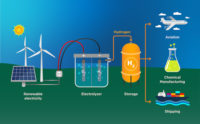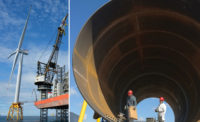German renewable energy developer Svevind Energy plans to produce three million tons of green hydrogen per year by building what is seen as a record size 45 GW of wind and solar energy plants across western and central Kazakhstan in a deal signed last month with a government investment arm.
The company also will build 30 GW in the country’s Mangystau region under a July 5 agreement with its local officials. The green hydrogen would be exported to European or Asian markets or used locally to produce products such as ammonia, steel or aluminum, the developer says.
Financing, engineering and procurement will take three to five years and construction and commissioning will take another five years, Svevind says. The company developed a cluster of connected wind farms in northern Sweden, the largest in Europe, totaling 1 GW and has another 1.5 GW under construction. It has been developing large-scale onshore wind power projects in Scandinavia since 1998.
Even so, efforts to develop a smaller but still sizable green hydrogen project in western Australia was set back in late June by a federal government ruling it as “unacceptable” because it threatened sensitive wetlands and migratory birds.
The estimated $36-billion Asian Renewable Energy Hub was on track to be one of the world’s largest renewable energy projects generating 26 GW of wind and solar energy for green hydrogen produced by 14 GW of electrolyzers for export to Asia. The government had given its private developer consortium “fast track” status last year and the project received state environmental approvals. It is being developed by InterContinental Energy, CWP Energy Asia, turbine maker Vestas and Macquarie Group.
Developers are working with the Australian environment agency to address its concerns “as we continue to work on the detailed design and engineering aspects of the project,” they said.
Australia can become a major hydrogen exporter in the 2030s due to its proximity to major Asian demand centers, says S&P Global, but cost of production needs to be cut in half.
Green hydrogen can be used as a fuel or feedstock and an energy carrier or for storage and is expected eventually to reduce use of coal, oil and natural gas.
Finiding a Role
But as developers work to get the price of green hydrogen competitive with fossil fuels, there is a valuable role for traditional exploration and production companies in the energy transition, says ConocoPhillips Chairman and CEO Rayan Lance.
“We must continue to meet demand on any energy transition pathway through the most disciplined capital allocation and strongest execution in the business,” he told analysts during a June 30 conference call. “We believe there is a valuable role for companies like ConocoPhillips in the energy transition.”
The company formed a low-carbon technology organization to identify global emissions reduction initiatives and evaluate and develop business opportunities for the energy transition, which could include carbon capture, use and storage, and blue and green hydrogen.
“As we look at blue hydrogen and even green hydrogen, when you look down the value chain, we see that we have quite a bit to offer in those spaces. It’s too early to say specifics, but certainly, we're working very hard on these opportunities,” Dominic Macklan, ConocoPhillips senior vice president for strategy and technology, told analysts.
The International Energy Agency said on July 5 that natural gas demand dropped by 1.9% in 2020 but is expected to rebound 3.6% in 2021. “And unless major policy changes to curb global gas consumption are introduced, demand is set to keep growing in coming years,” with a 7% rise from pre-COVID levels by 2024, the agency said.
Global oil demand is forecast to reach pre-pandemic levels by the end of 2022, IEA said in June. The agency said, however, that new government investments in fossil fuel production are “incompatible” with a net-zero economy.
The International Institute for Sustainable Development noted July 5 that Canada’s support for oil and gas infrastructure such as pipelines undermines its commitments to phase out inefficient fossil fuel subsidies.
“Government support for pipelines has been made on the assumption that the projects will provide economic benefits to Canadians, even as the oil and gas sector faces challenges,” the group’s report on Canadian support for pipelines said.
Such projects are increasingly being supported by the Canadian government, “yet government support to pipelines places public money at financial risk for current and future generations,” the institute said.






Post a comment to this article
Report Abusive Comment